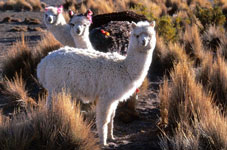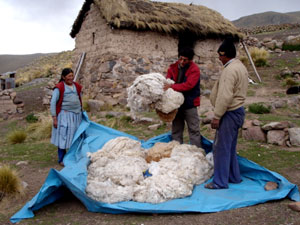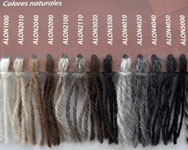Even though synthetic fibers have revolutionized the textile industry during the second half of the 20th century, natural fibers, such as alpaca fiber, are still highly appreciated. Caserita.com works with more than 20 artisan groups experts in alpaca fabrics so we are offering you here a detailed description of this extraordinary wool.
Alpaca wool is produced by the lama pacos or alpaca. The word alpaca refers to the animal and the wool (which is actually called fiber) and the textile produced with alpaca fiber.
This animal was domesticated more than 7000 years ago by Andean herders who produced a new species by crossing the vicuna with the guanaco. It is in the Camellidae family along with dromedaries, camels, llamas, vicuñas and guanacos. Today alpacas are found in the Peruvian and Bolivian Altiplano at altitudes over 3900 meters where the temperature can go as low as -15°C.
Previously reserved for Incan nobility, alpaca fiber is considered the gold of the Andes since this extraordinary fiber is recognized as one of the most luxurious in the world. Besides being durable, it is soft and warm, water resistant and hypoallergenic (since it does not contain lanolin), which makes it more valuable for babies and people who are allergic to sheep wool. Alpaca textiles continue to look new over time and do not release an odor like sheep wool does. It is 7 times warmer and 4 times more durable than sheep wool, and its feel is similar to cashmere. 
For 3000 years, the Bolivian and Peruvian Andes has been one of the regions in the world where the best fabrics were made. Even today in this region, beautiful fabrics are woven by Andean weavers’ masters. This weaving tradition was based on the existence of alpaca fiber.
The cellular composition of alpaca fiber is quite similar to human hair since it has a nucleus composed of cells filled with air that contributes greatly to its insulating qualities. Alpaca is the only animal that offers such a broad range of natural colors. Alpaca fiber can vary among 24 colors that are recognized today by textile industries, including whites, beige, ginger, brown, gray and black.

There are two types of alpaca: the suri that produces fiber for industrial use and the huacayas with a fiber used in crafted garments. Alpaca wool in Bolivia is classified by hand, based on softness and is separated into different classifications: Alpaca real (royal alpaca - less than 19 microns), Baby alpaca (22.5 microns), Super fine alpaca (25.5 microns) and Huarizo (29 microns). Fiber from 2-year-old alpacas is the softest and finest and is called baby alpaca. This fiber can be woven by itself or mixed with acrylic fibers, which is called alpacrill. The animals can be sheared every year. Their hair is from 15 to 20 cm long, and each alpaca yields between 2 and 3 kilos of fiber per year.
Anti-fur organizations will be pleased to know that it is not necessary to kill the animal in order to use its fiber.
Anecdotally, NASA used alpaca fiber because it is a natural fiber with the best thermal properties.
Even today, alpaca is important in the Andean economy since it provides meat as well as fiber, leather and fur for the textile industry.
Tips from Caserita.com to preserve your alpaca garments:

Be careful with moths! To protect your alpaca garments, you should package them in plastic bags during the summer or when you are not wearing them.
When you are using them, you should wash them regularly and store them with essential oils of eucalyptus, lemon, lavender or mint or anti-moth products.
As all luxury fibers, alpaca garments must be dry cleaned or washed in cold water with a baby shampoo.


